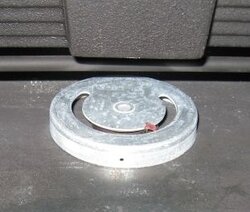Yesterday, I received three new stove thermometers ordered directly from the manufacturer. The single flue probe I've been using is about twenty years old, and not only did I think it might be time to replace it, but with several monitoring points on my stove, I thought it would be of interest to compare simultaneous readings at the different locations.
But first, I put all the thermometers - old and new - in the kitchen oven at 250*, along with an oven thermometer as well. Here (approximately) is what I got from each:
Oven - 225*
(New) stovepipe surface - 300*
(New) cat probe - 500*
(Old) flue probe - 600*
(New) flue probe - 700* (+)
In actual use, the thermometers also provided disparate results and different readings when swapped from one stove location to another for direct comparison. Even the two flue probes - old and new - didn't agree in temp ranges over 500*.
Needless to say, these 'findings' inspired a *whole* lot of confidence... and I have NO idea which thermometer I can actually trust... if any.
Yes, I was aware that the thermometers would not be perfectly accurate, and that only relative readings from a single thermometer in a single location were really meaningful for stove operation, but I sure didn't expect such a wild range of readings.
I would have spent my money better either buying two <identical> thermometers or a single IR to make periodic readings to compare with the old flue probe.
Lesson learned. I've reverted to simply using the old flue probe... because at least it provides 'familiar' readings.
Don't know offhand what to do with the others...
Peter B.
-----
But first, I put all the thermometers - old and new - in the kitchen oven at 250*, along with an oven thermometer as well. Here (approximately) is what I got from each:
Oven - 225*
(New) stovepipe surface - 300*
(New) cat probe - 500*
(Old) flue probe - 600*
(New) flue probe - 700* (+)
In actual use, the thermometers also provided disparate results and different readings when swapped from one stove location to another for direct comparison. Even the two flue probes - old and new - didn't agree in temp ranges over 500*.
Needless to say, these 'findings' inspired a *whole* lot of confidence... and I have NO idea which thermometer I can actually trust... if any.
Yes, I was aware that the thermometers would not be perfectly accurate, and that only relative readings from a single thermometer in a single location were really meaningful for stove operation, but I sure didn't expect such a wild range of readings.
I would have spent my money better either buying two <identical> thermometers or a single IR to make periodic readings to compare with the old flue probe.
Lesson learned. I've reverted to simply using the old flue probe... because at least it provides 'familiar' readings.
Don't know offhand what to do with the others...
Peter B.
-----



